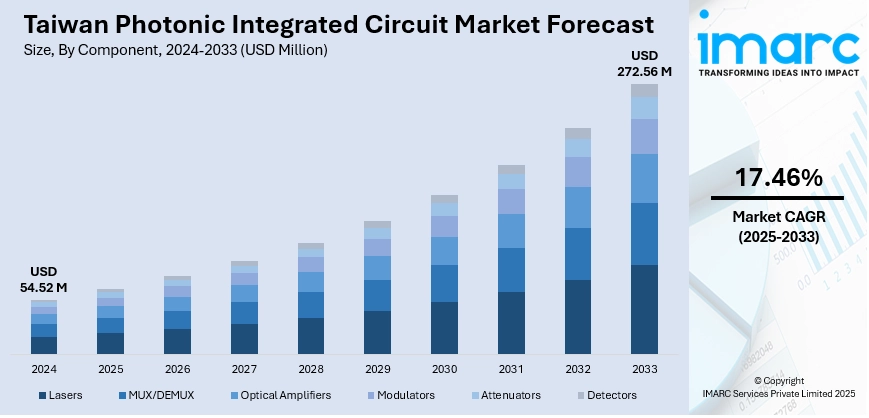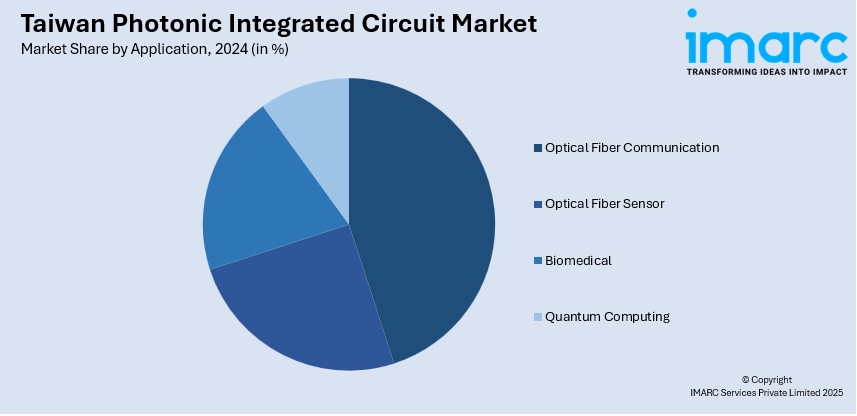
Taiwan Photonic Integrated Circuit Market Size, Share, Trends and Forecast by Component, Raw Material, Integration, Application, and Region, 2025-2033
Taiwan Photonic Integrated Circuit Market Overview:
The Taiwan photonic integrated circuit market size reached USD 54.52 Million in 2024. Looking forward, IMARC Group expects the market to reach USD 272.56 Million by 2033, exhibiting a growth rate (CAGR) of 17.46% during 2025-2033. Rising data traffic, adoption of high-speed communication networks, demand for energy-efficient components, advances in silicon photonics, and strong manufacturing and R&D support from its established semiconductor industry and government-backed technology initiatives are some of the factors contributing to the Taiwan photonic integrated circuit market share.
|
Report Attribute
|
Key Statistics
|
|---|---|
|
Base Year
|
2024
|
|
Forecast Years
|
2025-2033
|
|
Historical Years
|
2019-2024
|
| Market Size in 2024 | USD 54.52 Million |
| Market Forecast in 2033 | USD 272.56 Million |
| Market Growth Rate 2025-2033 | 17.46% |
Taiwan Photonic Integrated Circuit Market Trends:
Growth in Advanced PIC Solutions for Data Centers
Taiwan is experiencing accelerated development in photonic integrated circuit technologies designed to boost data transfer efficiency in large-scale computing systems. Recent solutions combine lasers and modulators into a single indium phosphide platform, achieving higher bandwidth with reduced energy use. The architecture supports both linear-drive and retimed optical connections, providing flexibility for diverse deployment scenarios. These advancements cater to the rising requirements of artificial intelligence, machine learning, and hyperscale facilities, where reliable, high-capacity links are essential. By enhancing local design and manufacturing capabilities, Taiwan is positioning itself as an important player in supplying next-generation optical transceivers. This evolution supports growing global demand for connectivity solutions that can handle increasingly complex workloads while maintaining efficiency and performance in modern infrastructure. These factors are intensifying the Taiwan photonic integrated circuit market growth. For example, in March 2025, Source Photonics Inc. debuted the world’s first 200G-per-lane multi-channel monolithic InP PIC single-mode IMDD technology in Taiwan, targeting 1.6Tbps and future 3.2Tbps transceivers for data centers. The InP-based solution, integrating DFB lasers and modulators, offers low power use, high bandwidth, and supports LPO and retimed optics. It also sets the stage for 400Gb/s-per-lane IMDD, advancing AI/ML cluster and hyperscale connectivity.

To get more information on this market, Request Sample
Collaboration Boosting Silicon Photonics Development
Taiwan’s semiconductor industry is moving forward in silicon photonics through strategic partnerships between global AI chipmakers and local manufacturing leaders. The collaboration focuses on creating photonic integrated circuits built on silicon, aimed at improving data center bandwidth and interconnect efficiency. Silicon photonics is increasingly seen as a key enabler for scaling cloud, AI, and high-performance computing infrastructure. Earlier efforts included working with leading design automation tool providers to strengthen integration processes and accelerate development cycles. These combined initiatives are expected to produce commercially viable solutions within the next few years, positioning Taiwan as a central hub for advanced optical technologies that support the growing demand for faster, more efficient, and scalable data center connectivity worldwide. For example, in January 2025, Nvidia, a leading AI chipmaker, partnered with Taiwan’s top semiconductor manufacturer, TSMC, to develop silicon photonics, with results expected in several years. Silicon photonics, which uses silicon to build photonic integrated circuits, is viewed as vital for increasing data center bandwidth and connectivity. The semiconductor firm previously collaborated with major EDA tool providers in 2024 to enhance its silicon photonics integration capabilities.
Taiwan Photonic Integrated Circuit Market Segmentation:
IMARC Group provides an analysis of the key trends in each segment of the market, along with forecasts at the country and regional levels for 2025-2033. Our report has categorized the market based on component, raw material, integration, and application.
Component Insights:
- Lasers
- MUX/DEMUX
- Optical Amplifiers
- Modulators
- Attenuators
- Detectors
The report has provided a detailed breakup and analysis of the market based on the component. This includes lasers, MUX/DEMUX, optical amplifiers, modulators, attenuators, and detectors.
Raw Material Insights:
- Indium Phosphide (InP)
- Gallium Arsenide (GaAs)
- Lithium Niobate (LiNbO3)
- Silicon
- Silica-on-Silicon
The report has provided a detailed breakup and analysis of the market based on the raw material. This includes indium phosphide (InP), gallium arsenide (GaAs), lithium niobate (LiNbO3), silicon, and silica-on-silicon.
Integration Insights:
- Monolithic Integration
- Hybrid Integration
- Module Integration
The report has provided a detailed breakup and analysis of the market based on the integration. This includes monolithic integration, hybrid integration, and module integration.
Application Insights:

- Optical Fiber Communication
- Optical Fiber Sensor
- Biomedical
- Quantum Computing
A detailed breakup and analysis of the market based on the application have also been provided in the report. This includes optical fiber communication, optical fiber sensor, biomedical, and quantum computing.
Regional Insights:
- Northern Taiwan
- Central Taiwan
- Southern Taiwan
- Eastern Taiwan
The report has also provided a comprehensive analysis of all the major regional markets, which include Northern Taiwan, Central Taiwan, Southern Taiwan, and Eastern Taiwan.
Competitive Landscape:
The market research report has also provided a comprehensive analysis of the competitive landscape. Competitive analysis such as market structure, key player positioning, top winning strategies, competitive dashboard, and company evaluation quadrant has been covered in the report. Also, detailed profiles of all major companies have been provided.
Taiwan Photonic Integrated Circuit Market News:
- In August 2025, Lightium AG, MPI Corporation, and Axiomatic_AI Inc. signed an MoU to develop the first intelligent, autonomous, and integrated test solution for photonic integrated circuits in Taiwan. The AI-driven platform would combine next-gen hardware with domain expertise to enhance testing precision, speed, and scalability, supporting the country’s growing photonics sector and addressing the increasing demand for advanced PIC device qualification.
Taiwan Photonic Integrated Circuit Market Report Coverage:
| Report Features | Details |
|---|---|
| Base Year of the Analysis | 2024 |
| Historical Period | 2019-2024 |
| Forecast Period | 2025-2033 |
| Units | Million USD |
| Scope of the Report |
Exploration of Historical Trends and Market Outlook, Industry Catalysts and Challenges, Segment-Wise Historical and Future Market Assessment:
|
| Components Covered | Lasers, MUX/DEMUX, Optical Amplifiers, Modulators, Attenuators, Detectors |
| Raw Materials Covered | Indium Phosphide (InP), Gallium Arsenide (GaAs), Lithium Niobate (LiNbO3), Silicon, Silica-on-Silicon |
| Integrations Covered | Monolithic Integration, Hybrid Integration, Module Integration |
| Applications Covered | Optical Fiber Communication, Optical Fiber Sensor, Biomedical, Quantum Computing |
| Regions Covered | Northern Taiwan, Central Taiwan, Southern Taiwan, Eastern Taiwan |
| Customization Scope | 10% Free Customization |
| Post-Sale Analyst Support | 10-12 Weeks |
| Delivery Format | PDF and Excel through Email (We can also provide the editable version of the report in PPT/Word format on special request) |
Key Questions Answered in This Report:
- How has the Taiwan photonic integrated circuit market performed so far and how will it perform in the coming years?
- What is the breakup of the Taiwan photonic integrated circuit market on the basis of component?
- What is the breakup of the Taiwan photonic integrated circuit market on the basis of raw material?
- What is the breakup of the Taiwan photonic integrated circuit market on the basis of integration?
- What is the breakup of the Taiwan photonic integrated circuit market on the basis of application?
- What is the breakup of the Taiwan photonic integrated circuit market on the basis of region?
- What are the various stages in the value chain of the Taiwan photonic integrated circuit market?
- What are the key driving factors and challenges in the Taiwan photonic integrated circuit market?
- What is the structure of the Taiwan photonic integrated circuit market and who are the key players?
- What is the degree of competition in the Taiwan photonic integrated circuit market?
Key Benefits for Stakeholders:
- IMARC’s industry report offers a comprehensive quantitative analysis of various market segments, historical and current market trends, market forecasts, and dynamics of the Taiwan photonic integrated circuit market from 2019-2033.
- The research report provides the latest information on the market drivers, challenges, and opportunities in the Taiwan photonic integrated circuit market.
- Porter's five forces analysis assist stakeholders in assessing the impact of new entrants, competitive rivalry, supplier power, buyer power, and the threat of substitution. It helps stakeholders to analyze the level of competition within the Taiwan photonic integrated circuit industry and its attractiveness.
- Competitive landscape allows stakeholders to understand their competitive environment and provides an insight into the current positions of key players in the market.
Need more help?
- Speak to our experienced analysts for insights on the current market scenarios.
- Include additional segments and countries to customize the report as per your requirement.
- Gain an unparalleled competitive advantage in your domain by understanding how to utilize the report and positively impacting your operations and revenue.
- For further assistance, please connect with our analysts.
 Request Customization
Request Customization
 Speak to an Analyst
Speak to an Analyst
 Request Brochure
Request Brochure
 Inquire Before Buying
Inquire Before Buying




.webp)




.webp)












